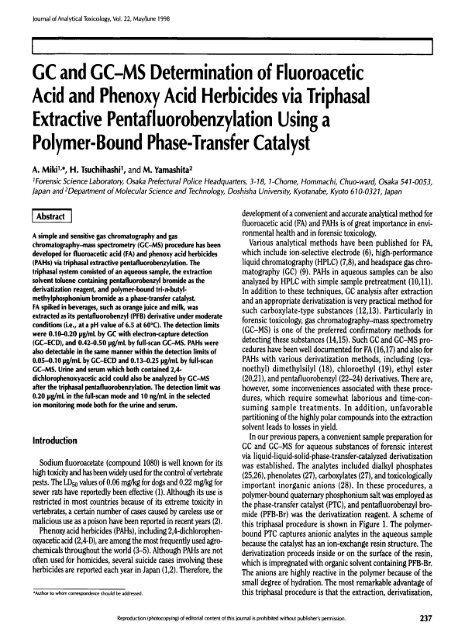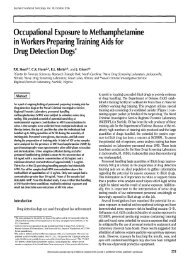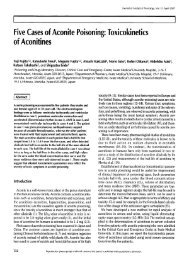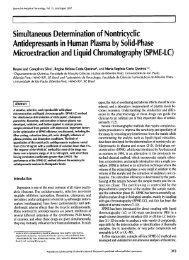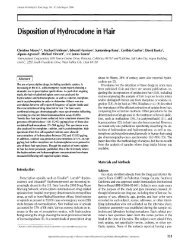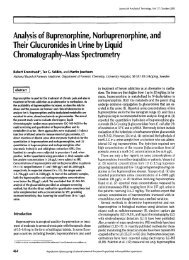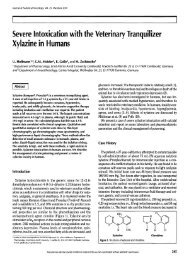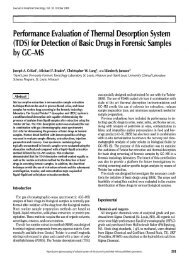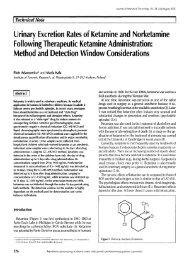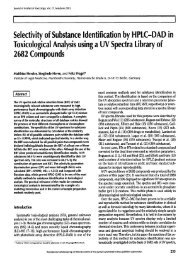GC and GC-MS Determination of Fluoroacetic Acid - Journal of ...
GC and GC-MS Determination of Fluoroacetic Acid - Journal of ...
GC and GC-MS Determination of Fluoroacetic Acid - Journal of ...
Create successful ePaper yourself
Turn your PDF publications into a flip-book with our unique Google optimized e-Paper software.
<strong>Journal</strong> <strong>of</strong> Analytical Toxicology, Vol. 22, May/June 1998<br />
<strong>GC</strong> <strong>and</strong> <strong>GC</strong>-<strong>MS</strong> <strong>Determination</strong> <strong>of</strong> <strong>Fluoroacetic</strong><br />
<strong>Acid</strong> <strong>and</strong> Phenoxy <strong>Acid</strong> Herbicides via Triphasal<br />
Extractive Pentafluorobenzylation Using a<br />
Polymer-Bound Phase-Transfer Catalyst<br />
A. Miki 1,*, H. Tsuchihashi 1, <strong>and</strong> M. Yamashita 2<br />
1Forensic Science Laboratory, Osaka Prefectural Police Headquarters, 3-18, 1-Chome, Hommachi, Chuo-ward, Osaka 541-0053,<br />
Japan <strong>and</strong> 2Department <strong>of</strong> Molecular Science <strong>and</strong> Technology, Doshisha University, Kyotanabe, Kyoto 610-0321, Japan<br />
I Abstrad I<br />
A simple <strong>and</strong> sensitive gas chromatography <strong>and</strong> gas<br />
chromatography-mass spectrometry (<strong>GC</strong>-<strong>MS</strong>) procedure has been<br />
developed for fluoroacetic acid (FA) <strong>and</strong> phenoxy acid herbicides<br />
(PAHs) via triphasal extractive pentafluorobenzylation. The<br />
triphasal system consisted <strong>of</strong> an aqueous sample, the extraction<br />
solvent toluene containing pentafluorobenzyl bromide as the<br />
derivatization reagent, <strong>and</strong> polymer-bound tri-n-butyl-<br />
methylphosphonium bromide as a phase-transfer catalyst.<br />
FA spiked in beverages, such as orange juice <strong>and</strong> milk, was<br />
extracted as its pentafluorobenzyl (PFB) derivative under moderate<br />
conditions (i.e., at a pH value <strong>of</strong> 6.5 at 60oc). The detection limits<br />
were 0.10-0.20 pg/mL by <strong>GC</strong> with eledron-capture detection<br />
(<strong>GC</strong>-ECD), <strong>and</strong> 0.42-0.50 pg/mL by full-scan <strong>GC</strong>-<strong>MS</strong>. PAHs were<br />
also detectable in the same manner within the detection limits <strong>of</strong><br />
0.05-0.10 pg/mL by <strong>GC</strong>-ECD <strong>and</strong> 0.13-0.25 pg/mL by full-scan<br />
<strong>GC</strong>-<strong>MS</strong>. Urine <strong>and</strong> serum which both contained 2,4-<br />
dichlorophenoxyacetic acid could also be analyzed by <strong>GC</strong>-<strong>MS</strong><br />
after the triphasal pentafluorobenzylation. The detection limit was<br />
0.20 pg/mL in the full-scan mode <strong>and</strong> 10 ng/mL in the seleded<br />
ion monitoring mode both for the urine <strong>and</strong> serum.<br />
Introdudion<br />
Sodium fluoroacetate (compound 1080) is well known for its<br />
high toxicity <strong>and</strong> has been widely used for the control <strong>of</strong> vertebrate<br />
pests. The LDso values <strong>of</strong> 0.06 mg/kg for dogs <strong>and</strong> 0.22 mg/kg for<br />
sewer rats have reportedly been effective (1). Although its use is<br />
restricted in most countries because <strong>of</strong> its extreme toxicity in<br />
vertebrates, a certain number <strong>of</strong> cases caused by careless use or<br />
malicious use as a poison have been reported in recent years (2).<br />
Phenoxy acid herbicides (PAHs), including 2,4-dichlorophen-<br />
oxyacetic acid (2,4-D), are among the most frequently used agro-<br />
chemicals throughout the world (3--5). Although PAHs are not<br />
<strong>of</strong>ten used for homicides, several suicide cases involving these<br />
herbicides are reported each year in Japan (1,2). Therefore, the<br />
*Author to whom correspondence should be addressed.<br />
development <strong>of</strong> a convenient <strong>and</strong> accurate analytical method for<br />
fluoroacetic acid (FA) <strong>and</strong> PAHs is <strong>of</strong> great importance in envi-<br />
ronmental health <strong>and</strong> in forensic toxicology.<br />
Various analytical methods have been published for FA,<br />
which include ion-selective electrode (6), high-performance<br />
liquid chromatography (HPLC) (7,8), <strong>and</strong> headspace gas chro-<br />
matography (<strong>GC</strong>) (9). PAHs in aqueous samples can be also<br />
analyzed by HPLC with simple sample pretreatment (10,11).<br />
In addition to these techniques, <strong>GC</strong> analysis after extraction<br />
<strong>and</strong> an appropriate derivatization is very practical method for<br />
such carboxylate-type substances (12,13). Particularly in<br />
forensic toxicology, gas chromatography-mass spectrometry<br />
(<strong>GC</strong>-<strong>MS</strong>) is one <strong>of</strong> the preferred confirmatory methods for<br />
detecting these substances (14,15). Such <strong>GC</strong> <strong>and</strong> <strong>GC</strong>-<strong>MS</strong> pro-<br />
cedures have been well documented for FA (16,17) <strong>and</strong> also for<br />
PAHs with various derivatization methods, including (cya-<br />
noethyl) dimethylsilyl (18), chloroethyl (19), ethyl ester<br />
(20,21), <strong>and</strong> pentafluorobenzyl (22-24)derivatives. There are,<br />
however, some inconveniences associated with these proce-<br />
dures, which r.equire somewhat laborious <strong>and</strong> time-con-<br />
suming sample treatments. In addition, unfavorable<br />
partitioning <strong>of</strong> the highly polar compounds into the extraction<br />
solvent leads to losses in yield.<br />
In our previous papers, a convenient sample preparation for<br />
<strong>GC</strong> <strong>and</strong> <strong>GC</strong>-<strong>MS</strong> for aqueous substances <strong>of</strong> forensic interest<br />
via liquid-liquid-solid-phase-transfer-catalyzed derivatization<br />
was established. The analytes included dialkyl phosphates<br />
(25,26), phenolates (27), carboxylates (27), <strong>and</strong> toxicologically<br />
important inorganic anions (28). In these procedures, a<br />
polymer-bound quaternary phosphonium salt was employed as<br />
the phase-transfer catalyst (PTC), <strong>and</strong> pentafluorobenzyi bro-<br />
mide (PFB-Br) was the derivatization reagent. A scheme <strong>of</strong><br />
this triphasal procedure is shown in Figure 1. The polymer-<br />
bound PTC captures anionic analytes in the aqueous sample<br />
because the catalyst has an ion-exchange resin structure. The<br />
derivatization proceeds inside or on the surface <strong>of</strong> the resin,<br />
which is impregnated with organic solvent containing PFB-Br.<br />
The anions are highly reactive in the polymer because <strong>of</strong> the<br />
small degree <strong>of</strong> hydration. The most remarkable advantage <strong>of</strong><br />
this triphasal procedure is that the extraction, derivatization,<br />
Reproduction (photocopyin 8) <strong>of</strong> editorial content <strong>of</strong> this journal is prohibited without publisher's permission. 237
<strong>and</strong> concentration <strong>of</strong> the resultant derivatives into small-<br />
volume organic layer are simultaneously achieved. Because<br />
the catalyst is in the form <strong>of</strong> bonded solid particles, this pro-<br />
cedure leads to easy layer separation <strong>and</strong> allows the injection<br />
<strong>of</strong> the organic layer into a <strong>GC</strong> instrument after only a simple<br />
cleanup.<br />
The present work has aimed to apply this triphasal procedure<br />
<strong>and</strong> facilitate the <strong>GC</strong> <strong>and</strong> <strong>GC</strong>-<strong>MS</strong> determination <strong>of</strong> FA <strong>and</strong> PAHs<br />
in various samples. The PAHs tested here are listed in Table I. In<br />
forensics, it is <strong>of</strong> great importance to detect poisons in trace<br />
amounts found at the scene (e.g., drink residues) <strong>and</strong> in biolog-<br />
ical samples <strong>of</strong> the victims. In order to efficiently determine<br />
these chemicals in various beverage samples, appropriate sample<br />
pretreatments were studied for each type <strong>of</strong> drink. The <strong>GC</strong>-<strong>MS</strong><br />
analysis <strong>of</strong> 2,4-D in urine <strong>and</strong> serum was also optimized to<br />
ensure the applicability <strong>of</strong> the triphasal extractive pentafluo-<br />
robenzylation to bi<strong>of</strong>luid samples.<br />
Experimental<br />
Materials<br />
Sodium salts <strong>of</strong> 2,4-D, 2-methyl-4-chlorophenoxyacetic<br />
acid (MCPA), <strong>and</strong> 2-methyl-4-chlorophenoxybutylic acid<br />
(MCPB) were supplied by Nissan Kagaku (Tokyo, Japan).<br />
Potassium salt <strong>of</strong> 2-(2-methyl-4-chlorophenoxy)propionic<br />
acid (MCPP) was provided by Kei-ai Kasei (Tokyo, Japan).<br />
Sodium salt <strong>of</strong> FA was obtained from Otsuka Yakuhin (Tokyo,<br />
Japan). PFB-Br (99%+), 1,3,5-tribromobenzene (TBB) (98%),<br />
<strong>and</strong> 2,4,6-trimethylbenzoic acid (TMBA) (99%+) were pur-<br />
chased from Aldrich (Milwaukee, WI). Tri-n-butylmethyl-<br />
phosphonium bromide polymer bound (0.75 meq. Br-/g<br />
[TB-0.751) was prepared from tri-n-butylmethylphosphonium<br />
chloride polymer bound (0.78 meq. Cl-/g 200-400 mesh,<br />
polystyrene-l% divinylbenzene copolymer, Fluka, Buchs,<br />
Switzerl<strong>and</strong>) according to a previously described manner<br />
(26). Sodium linear alkylbenzene sulfonate (LAS) <strong>and</strong> fatty<br />
238<br />
F F F F<br />
F~CH2--Br F~>-- CH2--O-- C-R<br />
II<br />
F F F F O<br />
PFB-Br ~x,~.~ /Org.<br />
~ @ _ _ ~ CH2_ p+ ~-~eluti~<br />
adsorption ~~/'~ Br, B~,~.-..~<br />
~ Aq.<br />
R-C-O- M + Br-<br />
II<br />
O<br />
Figure 1. Scheme <strong>of</strong> the triphasal extractive pentafluorobenzylation <strong>of</strong> carboxylates.<br />
)ournal <strong>of</strong> Analytical Toxicology, Vol. 22, May/June 1998<br />
acid ethanolamide (FAE) (1:1 type) were obtained from Kao<br />
(Tokyo, Japan). Florisil (60-100 mesh, P.R. grade) was pur-<br />
chased from Wako (Osaka, Japan). Phosphate buffers (0.1M,<br />
pH 4.5-9.2) were prepared by mixing 0.1M potassium dihy-<br />
drogen phosphate <strong>and</strong> 0.1M disodium hydrogen phosphate.<br />
All organic solvents <strong>and</strong> inorganic reagents were <strong>of</strong> analytical-<br />
reagent grade. Deionized <strong>and</strong> distilled water was used<br />
throughout.<br />
The river water used for experiments was sampled from<br />
Higashi-yokobori river at Chuo-ward (Osaka City, Japan). The<br />
pH <strong>and</strong> chemical oxygen dem<strong>and</strong> (COD) values were 6.8 <strong>and</strong> 11<br />
rag/L, respectively.<br />
Preparation <strong>of</strong> st<strong>and</strong>ards<br />
Stock st<strong>and</strong>ard solutions <strong>of</strong> each analyte (1.0 mg/mL aqueous<br />
solutions, adjusted to neutral pH with 0.1M sodium hydroxide<br />
<strong>and</strong>/or phosphoric acid) were prepared weekly <strong>and</strong> stored at<br />
0-5~ An aqueous st<strong>and</strong>ard solution containing FA, 2,4-D,<br />
MCPA, MCPB, <strong>and</strong> MCPP at 8.0 IJg/mL each was prepared, <strong>and</strong><br />
2.5-mL aliquots were used for the characterization <strong>of</strong> each<br />
derivative <strong>and</strong> optimization <strong>of</strong> the procedure. Spiked samples<br />
were prepared by the addition <strong>of</strong> known amounts <strong>of</strong> appropriately<br />
diluted st<strong>and</strong>ard solutions to blank samples.<br />
Triphasal extractive pentafluorobenzylation procedure<br />
River water <strong>and</strong> beverage samples. Before analysis, the<br />
sample pH was adjusted to approximately 7 with diluted<br />
sodium hydroxide <strong>and</strong> phosphoric acid. A 15-rag amount <strong>of</strong> the<br />
polymer-bound catalyst TB-0.75 was placed in a 20-mL, Teflon-<br />
sealed, stoppered glass test-tube. An aqueous sample (2.5 mL<br />
for beverages <strong>and</strong> 8.0 mL for river water samples), 0.1M phos-<br />
phate buffer (pH 6.5; 20% volume <strong>of</strong> the sample; i.e., 0.5 or 2.0<br />
mL), <strong>and</strong> toluene (0.4 mL) containing 3.0 pL (6.0 IJL, if nec-<br />
essary) <strong>of</strong> PFB-Br were successively added into the test-tube.<br />
The test-tubes were stoppered, sent to the test-tube evapo-<br />
rator "Vapor-mix" (Yamato rikagaku, Tokyo, Japan), <strong>and</strong> vig-<br />
orously shaken in a 60~ water bath (without evaporation).<br />
After an appropriate reaction time, the reaction was inhibited<br />
by the addition <strong>of</strong> 1.0M phosphoric acid (1.0 mL), <strong>and</strong> I mL <strong>of</strong><br />
n-hexane containing TBB (I.S.) at 2-pg/mL<br />
concentration was added. The organic layer<br />
was then withdrawn <strong>and</strong> filtered <strong>and</strong> dried by<br />
passage through the disposable Pasteur glass<br />
pipette plugged with a piece <strong>of</strong> cotton <strong>and</strong><br />
filled with 0.5 g <strong>of</strong> anhydrous sodium sulfide.<br />
A 1.0-pL aliquot was injected into the<br />
<strong>GC</strong>-ECD. After concentrating the extract to<br />
0.2-0.3 mL, a 1.0-1JL aliquot was subjected to<br />
<strong>GC</strong>-<strong>MS</strong>.<br />
Bi<strong>of</strong>luid samples. Serum <strong>and</strong> urine sam-<br />
ples (0.5 mL, adjusted to pH 6-7) were each<br />
diluted with 2.0 mL water <strong>and</strong> mixed with 0.5<br />
mL <strong>of</strong> 1.0-1Jg/mL TMBA (I.S.) aqueous solu-<br />
tion. Derivatization was performed in the<br />
manner described here; however, no buffer<br />
solution was added. After a 45-rain reaction at<br />
60~ n-hexane (1 mL for urine, 2 mL for<br />
serum) was added. The organic layers were
<strong>Journal</strong> <strong>of</strong> Analytical Toxicology, Vol. 22, May/June 1998<br />
Table I. Phenoxy <strong>Acid</strong> Herbicides (PAHs) Examined<br />
Abbreviation Herbicide Structure<br />
2,4-D<br />
MCPA<br />
MCPB<br />
MCPP<br />
Q<br />
s<br />
.m<br />
n<br />
o<br />
n-<br />
1<br />
0.5 84<br />
0.5<br />
9<br />
33<br />
2,4-Dichlorophenoxyacetic acid<br />
2-Methyl-4-chlorophenoxyacetic acid<br />
2-Methyl-4-chlorophenoxybutylic acid<br />
2-(2-Methyl-4-chlorophenoxy)propionic acid<br />
a@o(~-coo~<br />
- c~-ia<br />
L 258 M +<br />
61 161<br />
then separated (the mixtures were cen-<br />
trifuged if necessary) <strong>and</strong> applied onto florisil<br />
mini-columns. The columns were prepared<br />
in disposable glass pipettes filled with 0.3 g <strong>of</strong><br />
florisil <strong>and</strong> overlaid with 0.3 g anhydrous<br />
sodium sulfide. After washing the columns<br />
with 1 mL <strong>of</strong> n-hexane, they were eluted with<br />
1.5 mL <strong>of</strong> 30% ethyl acetate in toluene. The<br />
eluates were then concentrated to approxi-<br />
mately 200 pL with a gentle stream <strong>of</strong><br />
nitrogen, <strong>and</strong> 1.0-pL aliquots were injected<br />
into the <strong>GC</strong>-<strong>MS</strong>.<br />
Instrumentation<br />
<strong>GC</strong>-ECD. A <strong>GC</strong>-14A <strong>GC</strong> (Shimadzu, Kyoto,<br />
Japan) fitted with an electron-capture detector<br />
(Shimadzu clean ECD-C9, purge-gas type) was<br />
used. The detector temperature was set at<br />
l [ 1"<br />
, 9 I ,I ,I J _1 h J ~, ' J _ h.<br />
100 200 300<br />
m/z<br />
111 145<br />
175<br />
[]<br />
F175 161<br />
181 J 1 11 " ,,---'<br />
F F lgT_J o el<br />
J,l.,. ,. . . . .<br />
L195<br />
9 .I,<br />
[<br />
400 M*<br />
100 2OO m/z 300 400<br />
Figure 2. Electron impact mass spectra <strong>of</strong> the PFB derivatives <strong>of</strong> fluoroacetic acid (FA) (A) <strong>and</strong> 2,4-dichlorophenoxyacetic acid (2,4-D) (B).<br />
A<br />
B<br />
239
300~ <strong>and</strong> the purge gas was nitrogen at a flow rate <strong>of</strong> 35<br />
m~min. A DB-17 capillary column (30 m x 0.32-ram i.d., 0.25-<br />
pm film thickness, J&W Scientific, Folsom, CA) was used at a<br />
split ratio <strong>of</strong> 30:1. The column temperature was programmed<br />
from 90 to 270~ at 10~ The injector temperature was set<br />
at 300~ Helium was used as the carrier gas at a flow-rate <strong>of</strong> 2.0<br />
mL/min.<br />
<strong>GC</strong>-<strong>MS</strong>. A <strong>GC</strong><strong>MS</strong>-QP5050 <strong>MS</strong> (Shimadzu) was used in<br />
combination with a DB-1 megabore column (30 m x 0.53-ram<br />
i.d., 1.5-pm film thickness, J&W Scientific). Helium was used<br />
as carrier gas at a flow rate <strong>of</strong> 6.5 mL/min in the splitless<br />
mode. The column temperature was programmed from 70<br />
to 270~ at 10~ All measurements were performed<br />
with electron impact ionization. The ionization energy <strong>and</strong><br />
interface temperature were set at 70 eV <strong>and</strong> 250~ respec-<br />
tively.<br />
Results <strong>and</strong> Discussion<br />
Confirmation <strong>of</strong> the derivatives<br />
The corresponding PFB esters were identified as the deriva-<br />
tives <strong>of</strong> each analyte by <strong>GC</strong>-<strong>MS</strong>. All derivatives distinctively gave<br />
both M § <strong>and</strong> m/z 181 (i.e., [C6FsCH2 ]§ ions as well as their char-<br />
acteristic fragments. The mass spectra <strong>of</strong> the PFB derivatives <strong>of</strong><br />
FA <strong>and</strong> 2,4-D are shown in Figure 2. Particularly for the confir-<br />
mation <strong>of</strong> FA, PFB derivatization was found to be more advan-<br />
tageous than its methyl ester, which gave a very small molecular<br />
ion peak by electron impact ionization (9).<br />
Optimization <strong>of</strong> the derivatization<br />
Our fundamental studies (27) allowed us to set several param-<br />
eters for the triphasal extractive pentafluorobenzylation. These<br />
include the use <strong>of</strong> toluene as the extraction solvent, the use <strong>of</strong><br />
TB-0.75 as the catalyst, the appropriate amounts <strong>of</strong> PFB-Br <strong>and</strong><br />
TB-0.75, <strong>and</strong> the derivatization temperature as described in the<br />
experimental section.<br />
Sample pH. Our previous study (27) also indicated that the<br />
optimum sample pH was 4.5 for the derivatization <strong>of</strong> acetate<br />
anion. However, pH optimization was done for FA <strong>and</strong> 2,4-D<br />
because the pH <strong>of</strong> sample solution is one <strong>of</strong> the most sensitive<br />
factors in extractive derivatization. Figure 3 shows the results.<br />
Although the individual optimum pH values were 5.9 <strong>and</strong> 7.0<br />
for FA <strong>and</strong> 2,4-D, respectively, the pH for their simultaneous<br />
derivatization was set at 6.5 in the experiments described<br />
here.<br />
Derivatization time. The time course <strong>of</strong> the triphasal PFB<br />
derivatization <strong>of</strong> FA <strong>and</strong> PAHs is illustrated in Figure 4. The<br />
most appropriate reaction time was found to be 45 min at<br />
60~ for the simultaneous process. According to our basic<br />
experiments about triphasal pentafluorobenzylation <strong>of</strong> var-<br />
ious carboxylic acids (27), the derivatization yields <strong>of</strong> a variety<br />
<strong>of</strong> carboxylic acids ranged from 93 to 102%. (The exceptions<br />
were hippuric acid [HA] <strong>and</strong> L-tryptophan [Trp], which both<br />
have an amino group. The conversions to mono-substituted<br />
HA <strong>and</strong> di-substituted Trp were 81 <strong>and</strong> 75%, respectively).<br />
240<br />
<strong>Journal</strong> <strong>of</strong> Analytical Toxicology, Vol. 22, May/June 1998<br />
Although we did not measure the derivatization yields <strong>of</strong> FA<br />
<strong>and</strong> PAHs, the previous results (27) suggested that all <strong>of</strong> the<br />
PAHs <strong>and</strong> FA were semiquantitatively derivatized after a 45-<br />
rain reaction. A gas chromatogram obtained by the simulta-<br />
neous triphasal pentafluorobenzylation <strong>of</strong> FA <strong>and</strong> PAHs is<br />
shown in Figure 5A.<br />
Quantitative <strong>GC</strong> analysis. The calibration graphs for FA<br />
<strong>and</strong> 2,4-D by <strong>GC</strong>-ECD were constructed using stepwise diluted<br />
aqueous st<strong>and</strong>ard solutions <strong>and</strong> TBB as the internal st<strong>and</strong>ard.<br />
The graphs were linear over the ranges <strong>of</strong> 5,0-100 pg/mL (y =<br />
-0.02 + 1.19x, r 2 = 0.997) for FA<strong>and</strong> 2.5-50 IJg/mL (y = -0.01<br />
+ 0.67x, r ~ = 0.998) for 2,4-D. Incomplete conversions <strong>of</strong> FA<br />
I)<br />
!<br />
it<br />
0.5<br />
, i ~ J ;<br />
0 ~/ 5<br />
pH<br />
Figure 3. Effect <strong>of</strong> pH in the triphasal pentafluorobenzylation <strong>of</strong> FA <strong>and</strong><br />
2,4-D. The derivatization yields were determined after a reaction time <strong>of</strong><br />
20 min.<br />
0.5 ~ 0--~_<br />
o MOPP<br />
A MCPA<br />
o MCPB<br />
9 2,4-D<br />
9 FA<br />
13-<br />
e.-<br />
I I I ,<br />
0 20 40 60 80<br />
Reaction time (rain)<br />
Figure 4. Time course <strong>of</strong> the triphasal pentafluorobenzylation <strong>of</strong> FA <strong>and</strong><br />
PAHs.
<strong>Journal</strong> <strong>of</strong> Analytical Toxicology, Vol. 22, May/June 1998<br />
were observed at concentrations lower than 5.0 pg/mL. This<br />
was presumably due to the adsorption <strong>of</strong> FA to the glassware<br />
or vaporization <strong>of</strong> this polar but volatile compound. The rel-<br />
ative st<strong>and</strong>ard deviations (RSD) <strong>of</strong> the five consecutive mea-<br />
surements for FA <strong>and</strong> 2,4-D at 8.0 IJg/mL<br />
were 3.6 <strong>and</strong> 2.7%, respectively. The absolute<br />
detection limits <strong>of</strong> underivatized FA <strong>and</strong> 2,4-<br />
D by <strong>GC</strong>-flame-ionization detection were<br />
300 <strong>and</strong> 200 ng, respectively, based on the<br />
injection amount. PFB derivatization led to<br />
10 to 20 times more sensitive detection<br />
limits because <strong>of</strong> less polar <strong>and</strong> fairly volatile<br />
properties. PFB derivatives are preferably<br />
analyzed by <strong>GC</strong>-ECD, which takes advan-<br />
tage <strong>of</strong> the electron-capturing moiety. The<br />
absolute detection limits <strong>of</strong> around 0.05 ng<br />
were given for the PFB derivatives <strong>of</strong> FA <strong>and</strong><br />
PAHs by <strong>GC</strong>-ECD. _.....u<br />
Analysis <strong>of</strong> beverage samples<br />
In order to inspect the applicability <strong>of</strong> this<br />
triphasal procedure to practical forensics,<br />
recoveries were measured for FA <strong>and</strong> PAl-Is in<br />
spiked orange juice, milk, <strong>and</strong> the nutrient-<br />
refreshing drink called Oronamine C | The gas<br />
chromatograms obtained from the spiked juice<br />
<strong>and</strong> milk are shown in Figures 5B <strong>and</strong> 6A,<br />
respectively. Table II lists the recoveries <strong>of</strong> FA<br />
<strong>and</strong> PAHs from the spiked beverages at 8.0-<br />
pg/mL concentration. Each recovery was cal-<br />
culated by comparison <strong>of</strong> the relative peak<br />
intensity <strong>of</strong> an analyte in a spiked sample with<br />
that <strong>of</strong> one in the st<strong>and</strong>ard aqueous solution.<br />
The low recovery <strong>of</strong> FA from the orange juice<br />
can be explained as follows: the sample con-<br />
tains certain concentrations <strong>of</strong> various car-<br />
boxylic acids such as tertalic acid. During the<br />
derivatization, PFB-Br was presumably con-<br />
sumed for the derivatization <strong>of</strong> those acids.<br />
Therefore, FA, which is relatively polar <strong>and</strong> not<br />
quickly derivatized, was not completely defiva-<br />
tized. The conversion <strong>of</strong> FA improved when the<br />
quantity <strong>of</strong> PFB-Br was doubled (i.e., 6 pL).<br />
The lower recoveries from the milk sample<br />
were probably due to protein binding. The use<br />
<strong>of</strong> a doubled quantity <strong>of</strong> PFB-Br did not<br />
improve those recoveries.<br />
Effect <strong>of</strong> deproteinization. In order to<br />
achieve better recoveries <strong>of</strong> FA <strong>and</strong> PAHs from<br />
the milk, some preparative methods such as<br />
deproteinization were compared. The results<br />
are listed in Table III. Deproteinization with<br />
acetone was effective for PAHs; however, it<br />
decreased the recovery <strong>of</strong> FA, presumably<br />
because <strong>of</strong> the loss <strong>of</strong> the FA bound to the pro-<br />
tein. The gas chromatograms obtained from<br />
the spiked milk sample without any pretreat-<br />
ment <strong>and</strong> the one obtained after the depm-<br />
l<br />
i<br />
i<br />
teinization are shown in Figure 6.<br />
Sample dilution (five times weaker) before the derivatization<br />
increased the recoveries <strong>of</strong> FA <strong>and</strong> PAHs. This simple dilution<br />
was particularly effective in unbinding a polar compound such<br />
o~<br />
' 8 ' 1'2<br />
Retention time (min)<br />
~u4~<br />
Q<br />
3E<br />
A<br />
B<br />
JL......I<br />
i i !<br />
Figure 5. Gas chromatograms obtained from the triphasal pentafluorobenzylation <strong>of</strong> FA <strong>and</strong> PAHs<br />
in diluted aqueous st<strong>and</strong>ard solution (A) <strong>and</strong> spiked orange juice (B) at 8.0 pglmL each.<br />
Table II. Recoveries <strong>of</strong> FA* <strong>and</strong> PAHs from Spiked-Beverages Samples<br />
Analyle*<br />
Amount<br />
PFB-Br<br />
Recovery (%)<br />
(pL) Orange juice Oronamine C ~ Milk<br />
FA 3 25 59 48<br />
16<br />
6 56 62 47<br />
2,4-D 3 70 90 37<br />
6 81 89 40<br />
MCPA 3 75 98 39<br />
6 85 96 42<br />
MCPB 3 94 100 32<br />
6 97 98 37<br />
MCPP 3 92 96 55<br />
6 95 96 58<br />
" Abbreviations: FA, fluoroacetic acid; PAHs, phenoxy acid herbicides; PFB, pentafluorobenzyl;<br />
2,4-D, 2,4-dichlorophenoxyacetic acid; MCPA, 2-methyl-4-chlorophenoxyacetic acid; MCPB,<br />
2-methyl-4-chlorophenoxybutylic acid; MCPP, 2-(2-methyl-4-chlorophenoxy) propionic acid.<br />
The concentrations were 8.0 pg/rnL<br />
241
as FA. As we described in previous papers (26,27), the most<br />
remarkable advantage <strong>of</strong> the polymer-bound PTC is the function<br />
<strong>of</strong> capturing anions in a large-volume aqueous sample. FA <strong>and</strong><br />
0<br />
<<br />
IL<br />
i i i i<br />
8 12<br />
Retention time (rain)<br />
e4 9<br />
2L<br />
<strong>Journal</strong> <strong>of</strong> Analytical Toxicology, Vol. 22, May/June 1998<br />
PAils could be efficiently concentrated into the organic layer in<br />
the form <strong>of</strong> their PFB derivatives. This seemed most helpful for<br />
the microanalysis <strong>of</strong> anionic analytes in peptide-rich samples like<br />
milk <strong>and</strong> serum.<br />
The detection limits <strong>of</strong> FA <strong>and</strong> PAHs in the<br />
spiked samples by both <strong>GC</strong>-ECD <strong>and</strong> <strong>GC</strong>-<strong>MS</strong><br />
were measured by a combination <strong>of</strong> the most<br />
A appropriate pretreatment <strong>and</strong> derivatization<br />
t<br />
i i i<br />
16<br />
Figure 6, Gas chromatograms obtained from the spiked milk sample with 8.0 IJg/mL <strong>of</strong> FA <strong>and</strong><br />
PAHs. Without any pretreatment (A) <strong>and</strong> after deproteinization with acetone (B).<br />
Table III. Comparison <strong>of</strong> Pretreatment for the Triphasa[<br />
Pentafluorobenzylation <strong>of</strong> FA* <strong>and</strong> PAHs in the Spiked-Milk Sample<br />
Analyte t No pretreatment<br />
Recovery (%)<br />
Deproteinization* Dilutiont<br />
FA 48 28<br />
2, 4-D 37 63<br />
MCPA 39 65 77<br />
MCPB 32 78 86<br />
MCPP 55 88 92<br />
* Abbreviations: FA, fluoroacetic acid; PAHs, phenoxy acid herbicides; 2,4-D, 2,4-dichlorophenoxyacetic<br />
acid; MCPA, 2-methyl-4-chlorophenoxyacetic acid; MCPB, 2-methyl-4-chlorophenoxybutylic acid; MCPP,<br />
2 (2-methyl-4-chlorophenoxy) propionic acid.<br />
* The concentrations were 8.0 p~mL.<br />
* Deproteinization was done prior to the triphasal procedure as follows: acetone (2.0mL) was added to a<br />
sample (2.5 mL), followed by vortex mixing <strong>and</strong> storage for 1 h at 4~ to ensure complete precipitation. After<br />
centrifugation, a clear supernatant was separated. Acetone in the supernatant was then evaporated with a<br />
gentle stream <strong>of</strong> nitrogen at 50~<br />
A watered-down dilution (five times weaker) was made before the triphasal procedure.<br />
242<br />
B<br />
conditions for each drink. The results are listed<br />
in Table IV.<br />
Effect <strong>of</strong> surface-active agents. The<br />
extractive derivatization employed in this<br />
study is a triphasal process, <strong>and</strong> polymer-<br />
bound quaternary salt PTCs act as cationic<br />
surface-active reagents. It is, therefore, <strong>of</strong><br />
great importance to examine the effects <strong>of</strong><br />
coexisting surface-active agents in the pro-<br />
cedure. The authors tested the effects <strong>of</strong><br />
sodium linear alkylbenzene sulfonate (LAS)<br />
as an anionic surface-active agent <strong>and</strong> fatty<br />
acide ethanolamide (FAE) as a neutral sur-<br />
face-active agent. Both are among the most<br />
widely used surface-active agents, not only<br />
in various industries, but also as major<br />
ingredients in domestic detergents. In<br />
domestic detergents, these two types <strong>of</strong><br />
agents are usually compounded at a ratio <strong>of</strong><br />
approximately 1:1. The samples used for the<br />
experiment were the river water samples<br />
spiked with each <strong>of</strong> the agrochemicals at a<br />
concentration <strong>of</strong> 1.25 pg/mL <strong>and</strong> with LAS<br />
or FAE or both at concentrations <strong>of</strong> 0-1000<br />
IJg/mL. The results are listed in Table V.<br />
Although the presence <strong>of</strong> LAS gave no<br />
noticeable effects, the coexistence <strong>of</strong> FAE<br />
at 1000 pg/mL obviously increased the<br />
recovery <strong>of</strong> FA. This was possibly because<br />
the presence <strong>of</strong> neutral surface-active agent<br />
63 FAE led to a smoother phase transfer <strong>and</strong><br />
to a quicker derivatization <strong>of</strong> the polar<br />
anion. The gas chromatograms obtained<br />
76 from the spiked river water samples with<br />
<strong>and</strong> without these surface-active agents are<br />
compared in Figure 7.<br />
Analysis <strong>of</strong> serum <strong>and</strong> urine samples<br />
Generally, ingested FA is rapidly converted<br />
to fluorocitrate, a potent inhibitor <strong>of</strong> aconi-<br />
tase; therefore, the detection <strong>of</strong> FA in biological<br />
tissues is impractical (1). According to<br />
Allender (17), the concentration <strong>of</strong> FA in<br />
stomach/gizzard contents <strong>of</strong> a magpie that had<br />
ingested bait containing FA was quite low<br />
(approximately 1 pg/g). Kancir et al. (5), how-<br />
ever, reported that 82.4% <strong>of</strong> ingested 2,4-D<br />
was excreted in urine, <strong>and</strong> only 12.8% was ex-<br />
creted as conjugates.<br />
In terms <strong>of</strong> biological samples, the sample
<strong>Journal</strong> <strong>of</strong> Analytical Toxicology, Vol. 22, May/June 1998<br />
matrix <strong>of</strong>ten prevents promising methods moving from the out-<br />
line stage to working procedures. Therefore, 2,4-D in serum<br />
<strong>and</strong> urine was analyzed to ensure the applicability <strong>of</strong> the<br />
triphasal procedure to bi<strong>of</strong>luid samples. The analysis was carried<br />
out by <strong>GC</strong>-<strong>MS</strong> in order to enhance the selec-<br />
tivity for detection at low levels.<br />
As the 2,4-D level in authentic bi<strong>of</strong>luid sam-<br />
pies may range very widely, the <strong>GC</strong>-<strong>MS</strong> was<br />
performed both in the full-scan <strong>and</strong> selected<br />
ion monitoring modes. Although PAH ana-<br />
logues, such as 2,4,5-T (24), are commonly<br />
used as the internal st<strong>and</strong>ard, we adopted the<br />
aromatic carboxylic acid TMBA to avoid dupli-<br />
cation <strong>of</strong> an authentic ingredient <strong>of</strong> forensic<br />
interest. TMBA, which behaved almost identi-<br />
cally to 2,4-D during the derivatization <strong>and</strong><br />
cleanup, was added before the analysis. Figure<br />
8 shows the mass chromatograms obtained<br />
from the fortified serum <strong>and</strong> urine samples<br />
with 2,4-D at 0.25 pg/mL. The analysis was<br />
performed in the selected ion monitoring<br />
mode. The additional cleanup <strong>of</strong> the resultant<br />
organic layer by passage through a florisil<br />
mini-column was effective in reducing matrix<br />
interference. The calibration graphs were<br />
drawn by measuring the peak areas at rn/z 400<br />
for 2,4-D against that at m/e 163 for TMBA<br />
(internal st<strong>and</strong>ard). The graphs were both<br />
linear over the range <strong>of</strong> 2.5 Bg/mL to 50 ng/mL<br />
(.r = -0.061 + 5.61x, r 2 = 0.996 for serum <strong>and</strong><br />
y = -0.101 + 5.39x, r ~ = 0.997 for urine). The<br />
detection limits were 10 ng/mL in the selected<br />
ion monitoring mode <strong>and</strong> 0.20 pg/mL in the<br />
full-scan mode for both the serum <strong>and</strong> urine.<br />
The recoveries <strong>and</strong> RSDs <strong>of</strong> the whole proce-<br />
dure evaluated at a concentration <strong>of</strong> 1.0 pg/mL<br />
were 85 <strong>and</strong> 6.2%, respectively, for the serum<br />
<strong>and</strong> 92 <strong>and</strong> 4.9%, respectively, for the urine.<br />
Conclusion<br />
In recent years, liquid chromatographic-<br />
mass spectrometric technology has been<br />
increasingly used in the confirmation anal-<br />
ysis <strong>of</strong> aqueous substances. However, <strong>GC</strong>-<strong>MS</strong><br />
still has advantages, such as easier operation<br />
<strong>and</strong> lower instrument costs. <strong>GC</strong>-<strong>MS</strong> has<br />
made a large contribution to practical routine<br />
analyses. The informative mass spectra pro-<br />
vided by <strong>GC</strong>-<strong>MS</strong> with an appropriate deriva-<br />
tization are indispensable for confirmation<br />
analysis, particularly in forensics. In order<br />
to establish a convenient sample pretreat-<br />
ment for <strong>GC</strong> <strong>and</strong> <strong>GC</strong>-<strong>MS</strong> analysis <strong>of</strong> car-<br />
boxylic acid-type agrochemicals, triphasal<br />
extractive pentafluombenzylation was applied<br />
6<br />
I<br />
as the key step in the sample pretreatment. The polymer-bound<br />
phosphonium phase-transfer catalyst TB-0.75 allowed us to<br />
simultaneously perform the extraction, concentration, <strong>and</strong><br />
derivatization <strong>of</strong> carboxylate analytes in an aqueous sample.<br />
e~ Q<br />
~E<br />
Retention time (min)<br />
Figure 7. Gas chromatograms obtained from the spiked river water with 1.25 pg/mL <strong>of</strong> FA <strong>and</strong><br />
PAHs. No surface-adive agents were spiked (A). The surface-active agents LAS <strong>and</strong> FAE were added<br />
at 1000 pg/mL each (B).<br />
Table IV. Detection Limits <strong>of</strong> FA <strong>and</strong> PAHs in Spiked Samples by <strong>GC</strong>-ECD<br />
<strong>and</strong> <strong>GC</strong>-<strong>MS</strong><br />
Detection limit (pg/mL)<br />
Orange juice* Milk* River Water ~<br />
Anal~e * <strong>GC</strong>-ECDi <strong>GC</strong>-/VlS iN <strong>GC</strong>-ECDS <strong>GC</strong>-/VlS a <strong>GC</strong>-ECDS <strong>GC</strong>-IVlS it<br />
FA 0.10 0.42 0.20 0.50 0.013 0.033<br />
2,4-D 0.07 0.20 0.10 0.25 0.007 0.033<br />
MCPA 0.07 0.20 0.10 0.25 0.005 0.020<br />
MCPB 0.05 0.15 0.07 0.15 0.005 0.020<br />
MCPP 0.05 0.13 0.07 0.20 0.005 0.025<br />
* Six microliters PFB-Br was used.<br />
A watered-down dilution (five times weaker) was made prior to the triphasal procedure.<br />
The sample volume was 8.0 mL.<br />
S/N =3. Average for three repeated measurements.<br />
II Detection limit <strong>of</strong> five major peaks including M + in the full scan mode; this is the average for<br />
three repeated measurements.<br />
A<br />
B<br />
243
This concentration effect was potent for analytes in a rela-<br />
tively large volume <strong>of</strong> aqueous sample. Using these advan-<br />
tages, the detection <strong>of</strong> polar chemicals was successfully<br />
performed even in protein-rich samples, such as milk <strong>and</strong><br />
Table V. Influences <strong>of</strong> Surface-Active Agents in the Triphasal<br />
Pentafluorobenzylation <strong>of</strong> FA* <strong>and</strong> PAHs in Spiked River Water<br />
Recovery (%)<br />
Concentrations <strong>of</strong> surface-active agents (mg/t)<br />
Anal~e t LAS* 0 250 1000 0 1000<br />
FAEt 0 250 0 1000 1000<br />
FA 44 44 42 59 62<br />
2,4-D 58 58 57 56 54<br />
MCPA 59 59 55 60 55<br />
MCPB 60 64 63 64 65<br />
MCPP 62 60 58 65 65<br />
* Abbreviations: FA, fluoroacetic acid; PAHs, phenoxy acid herbicides; LAS, sodium linear alkybenzene; FAE,<br />
fatty acid ethanolamide; 2,4-D, 2,4-dichlorophenoxyacetic acid; MCPA, 2-methyl-4-chlorophenoxyacetic<br />
acid; MCPB, 2-methyl-4-chlorophenoxybutylic acid; MCPP, 2-(2-methyl-4-chlorophenoxy) propionic acid.<br />
+ The concentrations were 1.25 pg/mL.<br />
* Sodium linear alkylbenzene sulfonate.<br />
w Fatty acid ethanolamide.<br />
a<br />
A<br />
,- 402x2<br />
. . . . 400 x 2<br />
"----'--'---~ 177 x 2<br />
~ "-----'--'--'--- 175 x 2<br />
~---------~ 145 x 2<br />
~ 1 1 1 x 2<br />
- 344Xl<br />
~-----"---~ 163 x 1<br />
12.2 ?2 Is 12.2<br />
Retention time (rain)<br />
244<br />
<strong>Journal</strong> <strong>of</strong> Analytical Toxicology, Vol. 22, May/June 1998<br />
serum, after simple dilution with water. The authors will con-<br />
tinue to pursue other extensive applications <strong>of</strong> this technique<br />
in the forensic chemistry <strong>and</strong> toxicology fields.<br />
r<br />
References<br />
Figure 8. Mass chromatograms obtained from the serum (A) <strong>and</strong> urine (B) samples containing 2,4-D at 0.25 pg/mL.<br />
1. Pharmaceutical Society <strong>of</strong> Japan. 5t<strong>and</strong>ard<br />
Methods <strong>of</strong> Chemical Analysis in Poisoning.<br />
Nanzan-do, Tokyo, Japan, 1992, pp 383-388.<br />
2. Japanese National Research Institute <strong>of</strong> Police<br />
Science. Annual Case Reports <strong>of</strong> Drug <strong>and</strong> Toxic<br />
Poisoning in Japan. Vols. 20-39, Japanese<br />
National Research Institute <strong>of</strong> Police Science,<br />
Tokyo, 1977-1996.<br />
3. World Health Organization. 2,4-Dichlorophen-<br />
oxyacetic acid (2,4-D). Environmental Health<br />
Criteria, Geneva, Switzerl<strong>and</strong>. W.H.O. Monogr.<br />
Ser. 29:1-44 (1984).<br />
4. J. Osterloh, M. Lotti, <strong>and</strong> S. Pond. Toxicological<br />
studies in a fatal overdose <strong>of</strong> 2,4-D, MCPP <strong>and</strong><br />
chlorpyrifos. J. Anal ToxicoL 7:125-129 (1983).<br />
5. C.B. Kancir, C. Andersen, <strong>and</strong> A.S. Olesen.<br />
Marked hypocalcemia in a fatal poisoning with<br />
chlorinated phenoxy acid derivatives. Olin. Tox-<br />
icoL 26(3-4): 257-264 (1988).<br />
6. G. Livanos <strong>and</strong> P.J. Milham. Fluoride ion-selec-<br />
tive electrode determination <strong>of</strong> sodium mon<strong>of</strong>lu-<br />
oroacetate in meat baits <strong>and</strong> formulations.<br />
J. Assoc. Off. Anal Chem. 67(1): 10-12 (1984).<br />
7. D.M. Collins, J.P. Fawcett <strong>and</strong> C.G. Rammell.<br />
<strong>Determination</strong> <strong>of</strong> sodium fluoroacetate (com-<br />
pound 1080) in poison baits by HPLC. Bull.<br />
Environ. Contam. Toxicol. 26:669-673 (1981 ).<br />
L 9<br />
i<br />
.L<br />
B<br />
181 x 1<br />
402 x 5<br />
400 x 5<br />
-177x5<br />
175x5<br />
145x5<br />
111x5<br />
344x2<br />
163x2<br />
15 1~.5<br />
Retention time (min)
<strong>Journal</strong> <strong>of</strong> Analytical Toxicology, Vol. 22, May/June 1998<br />
8. A.C. Ray, L.O. Post, <strong>and</strong> J.C. Reager. High pressure liquid chro-<br />
matographic determination <strong>of</strong> sodium fluoroacetate (compound<br />
1080) in canine gastric content. J. Assoc. ~ Anal. Chem. 64(1):<br />
19-24 (1981).<br />
9. M. Mori, H. Nakajima, <strong>and</strong> Y. Seto. <strong>Determination</strong> <strong>of</strong> fluoroacetate<br />
in aqueous samples by headspace gas chromatography. J. Chro-<br />
matogr. 736:229-234 (1996).<br />
10. Th. Keller, G. Skopp, M. Wu, <strong>and</strong> R. Aderjan. Fatal overdose <strong>of</strong><br />
2,4-dichlorophenoxyacetic acid (2,4-D). Forensic 5cL Int. 65:13-18<br />
(1994).<br />
11. A. Balinova. Ion-pairing mechanism in the solid-phase extraction<br />
<strong>and</strong> reverse-phase high-performance liquid chromatographic deter-<br />
mination <strong>of</strong> acidic herbicides in water. J. Chromatogr. 728:319-324<br />
(1996).<br />
12. J.D. Kohli, R.N. Kuanna, B.N. Gupta, M.M. Dahr, J.S. T<strong>and</strong>on, <strong>and</strong><br />
K.P. Sircar. Absorption <strong>and</strong> excretion <strong>of</strong> 2,4-dichlorophenoxyacetic<br />
acid in man. Xenobiotica 4(2): 97-100 (1974).<br />
13. G.E. Schulze, J.W. Blake, <strong>and</strong> J.A. Dougherty. The metabolic fate <strong>of</strong><br />
2,4-dichlorophenoxyacetic acid-n-butyl ester in the wister rat. Arch.<br />
Toxicol. 57:231-236 (1985).<br />
14. K. Pfleger, H.H. Mourer, <strong>and</strong> A. Weber. Mass Spectral <strong>and</strong> <strong>GC</strong> Data<br />
<strong>of</strong> Drugs, Poisons, Pesticides, Pollutants <strong>and</strong> Their Metabolites, 2nd<br />
ed. VCH Verlag Sgesellschaft, Weinheim, Germany, 1992.<br />
15. A.C. M<strong>of</strong>fat, J.V. Jackson, M.S. Moss, <strong>and</strong> B. Widdop, Eds. Clark's Iso-<br />
lation <strong>and</strong> Identification <strong>of</strong> Drugs, 2nd ed. The Pharmaceutical<br />
Press, London, U.K., 1986.<br />
16. I. Okuno <strong>and</strong> D.L. Meeker. Gas-liquid chromatographic determi-<br />
nation <strong>of</strong> sodium fluoroacetate (compound 1080). J. Assoc. Off.<br />
Anal Chem. 63:49-55 (1980).<br />
17. W.J. Allender. <strong>Determination</strong> <strong>of</strong> sodium fluoroacetate (compound<br />
1080) in biological tissues. J. Anal Toxicol. 14:45-49 (1990).<br />
18. M.J. Bertr<strong>and</strong>, A.W. Ahmed, B. Sarrasin, <strong>and</strong> V.N. Mallet. Gas chro-<br />
matographic <strong>and</strong> mass spectrometric determination <strong>of</strong> chlorophe-<br />
noxy acids <strong>and</strong> related herbicides as their (cyanoethyl) dimethylsilyl<br />
derivatives. AnaL Chem. 59:1302-1306 (1987).<br />
19. H. Agemian <strong>and</strong> A.S.Y. Chau. Analysis <strong>of</strong> pesticide residues by<br />
chemical derivatization. J. Assoc. Off. Anal Chem. 60:1070-1078<br />
(1977).<br />
20. C. S,~nchez-Brunete, A.I. Garda-Valc,~rcel, <strong>and</strong> J.L. Tadeo. Deter-<br />
mination <strong>of</strong> residues <strong>of</strong> phenoxy acid herbicides in soil <strong>and</strong> cereals<br />
by gas chromatography-ion trap detection. J. Chromatogr. 675:<br />
213-218 (I 994).<br />
21. M. Tatsuno, M. Katagi, <strong>and</strong> H. Tsuchihashi. Fused silica capillary<br />
gas chromatography <strong>of</strong> phenoxy acid herbicides with ethyl esteri-<br />
fication. Rep. Natl. Res. Inst. Police Sci. 43(4): 154-160 (1990).<br />
22. H.D. Meiring, G. den Engelsman, <strong>and</strong> A.P.J.M. de Jong. Determi-<br />
nation <strong>of</strong> polar pesticides by phase-transfer catalysed derivatization<br />
<strong>and</strong> negative-ion chemical ionization gas chromatography-<br />
mass spectrometry. J. Chromatogr. 644:357-365 (1993).<br />
23. M. Vink <strong>and</strong> J.M. van der Poll. Gas chromatographic determination<br />
<strong>of</strong> acid herbicides in surface water samples with electron-capture<br />
detection <strong>and</strong> mass spectrometric confirmation. ]. Chromatogr.<br />
733:361-366 (I 996).<br />
24. G.H. Oliveira <strong>and</strong> J. Palermo-Neto. Toxicology <strong>of</strong> 2,4-dichlorophe-<br />
noxyacetic acid (2,4-D) <strong>and</strong> its determination in serum <strong>and</strong> brain<br />
tissue using gas chromatography-electron-capture detection.<br />
J. Anal. To 19= 251-55 (1995).<br />
25. A. Miki, H. Tsuchihashi, K. Ueda, <strong>and</strong> M. Yamashita. Extractive<br />
derivatization <strong>of</strong> aqueous drugs using polymeric phase transfer<br />
catalysts I. Jpn. J. ToxicoL Environ. Health 38:168-I 75 (I 992).<br />
26. A. Miki, H. Tsuchihashi, K. Ueda, <strong>and</strong> M. Yamashita. Gas chro-<br />
matographic determination <strong>and</strong> gas chromatographic-mass spec-<br />
trometric determination <strong>of</strong> dialkyl phosphates via extractive<br />
pentafluorobenzylation using a polymeric phase transfer catalysts.<br />
J. Chromatogr. 718:383-389 (1995).<br />
27. A. Miki, H. Tsuchihashi, H. Yamano, <strong>and</strong> M. Yamashita. Extractive<br />
pentafluorobenzylation using a polymeric phase-transfer cata-<br />
lyst--A convenient one-step pretreatment for gas chromatographic<br />
analysis <strong>of</strong> anionic compounds. AnaL Chim. Acta 356:165-175<br />
(1997).<br />
28. A. Miki, H. Tsuchihashi, K. Ueda, H. Yamano, <strong>and</strong> M. Yamashita.<br />
Gas chromatographic <strong>and</strong> gas chromatography/mass spectro-<br />
metric determination <strong>of</strong> aqueous poisons via extractive pentaflu-<br />
orobenzylation using polymeric phase-transfer catalyst.<br />
Proceedings <strong>of</strong> the 30th International Meeting <strong>of</strong> the Interna-<br />
tional Association <strong>of</strong> Forensic Toxicologists, Fukuoka, Japan,<br />
1992, pp 419-424.<br />
Manuscript received June 9, 1997;<br />
revision received October 30, 1997.<br />
245


